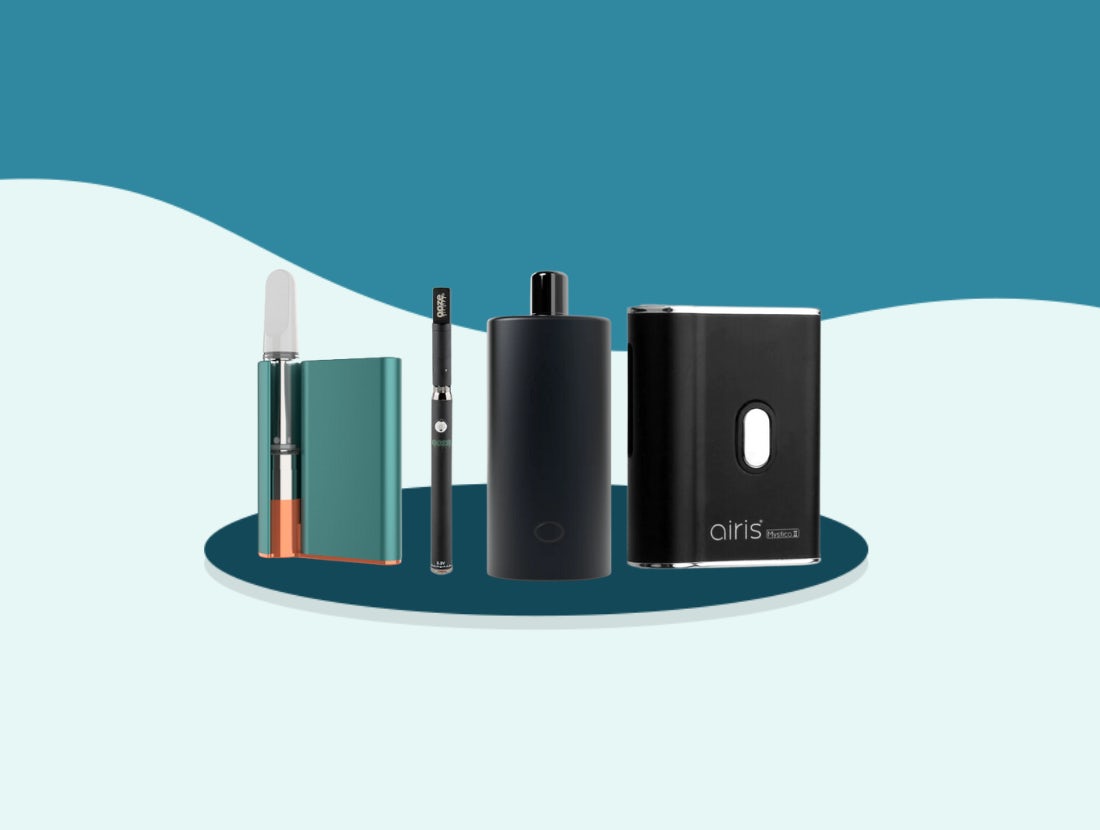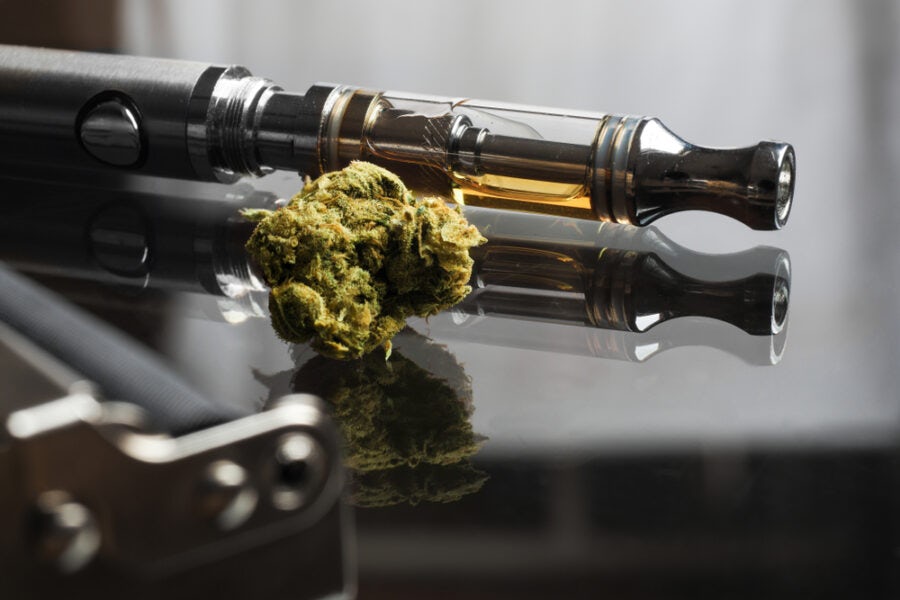Vaping entails heating up cannabis (or another substance) until it creates a vapor that can be inhaled. It doesn’t require the inhalation of any combusted materials, and can be an easier, more palatable option for people who are turned off by smoking.
From coffee table “volcanos” to pocket vapes barely the size of a Zippo, there’s a vape for everyone today, and a growing appreciation for the benefits of vaping marijuana.
How are vaping and smoking different?
Both vaping and smoking involve inhaling heated cannabinoids into your airways, but that’s where the similarities end.
With smoking, the cannabis is combusted (aka burnt) by a flame, producing smoke filled with particulates that are inhaled. The combustion required for smoking can produce thousands of small chemicals, including hundreds of carcinogens also found in tobacco smoke.
Vapor is the byproduct of vaporization, which occurs when you heat a liquid or solid to a point where it is converted into a gas. There is no pyrolysis (aka burning of the plant material), so no smoke enters the equation, and far fewer harmful chemicals are created.
For both vaping and smoking, the onset is fast — the effects can be felt almost instantly, with the full onset happening within a matter of minutes and peak effects achieved in about 30 minutes.

The pros and cons of vaping marijuana
Pro: Vaping is less harmful than smoking
While there are health risks involved in vaping, it is considered less harmful than smoking. In the 2018 publication, “Public Health Consequences of E-Cigarettes,” the authors wrote that “there is substantial evidence that except for nicotine, under typical conditions of use, exposure to potentially toxic substances from e-cigarettes is significantly lower compared with combustible tobacco cigarettes.”
In addition to the lower number of toxic substances, one of the main benefits of vaping weed is the fact that it doesn’t involve inhaling smoke, making it a more safer option for people with respiratory issues or for those who just want to avoid smoke.
Con: Vaping requires a vaporizer and power
While every cannabis smoker has certainly lost a lighter or two, by and large the entire process of smoking a joint is simple — have paper, lighter, and cannabis, will travel. Vaping, on the other hand, requires the purchase of a vaporizer, as well as making sure that it’s charged up and ready when you are. These vaporizers can be pricey and can be a little work to clean and maintain, so vaporizing may not always be as convenient as smoking.
Pro: Fewer carcinogens in vaping
In a 2014 study, researchers tested vapors made by 12 different brands, and found that while they did contain toxic substances, “the levels of toxicants were 9 to 450 times lower than in cigarette smoke and were, in many cases, comparable to trace amounts found in the reference product.”
A 2017 study concluded that “using e-cigarettes alone results in very low exposure to toxins and carcinogens,” and observed that six months after switching to vaping only, former smokers had much lower levels of some of the more dangerous carcinogens found in tobacco smoke.
Con: Vaping can be habit forming
The ease of vaping and the fact that it doesn’t require smoking has made it a popular consumption method for people who otherwise may not be likely to try smoking. This is mainly a concern when it comes to nicotine vapes, with one 2020 report stating that adolescents who use e-cigarettes “are 3.6 times more likely to report using combustible cigarettes later in life.”
In addition, the advent of cannabis cartridges has made consuming cannabis more discreet than ever. They also deliver a highly bioavailable vapor that can spike blood levels of cannabinoids. This allows for regular use at any time of day, and increases overall risk for misuse. Certainly this doesn’t apply to all individuals using vaporizers, but it is something to consider in individuals at risk of cannabis misuse (namely youth).

Pro: Vaping is more discreet
Vaping does produce a rather distinctive odor but it’s far less acrid and doesn’t linger like marijuana smoke. For people vaping at home this means no need to get off the couch and head out to the back porch. Also, when you’re out and about vaping, it’s much less likely to alert everyone in a wide radius that you’re smoking cannabis.
Pro: Better dosing, flavors, and bioavailability
With vaping pens and cartridges, users have the potential to really nail their dosing with precision. Some more advanced vapes allow the user to preset the amount of THC or CBD they want per session — even down to the miligram. For medical cannabis patients, this can make it much easier to ensure they are meeting their specific dosing regimen.
Additionally, many users report a more flavorful experience because vaped flower is heated but not combusted, which preserves many of the volatile terpenes that many contribute to the entourage effects.
Some research has also found that the vaping cannabis may deliver more THC to the bloodstream than smoking. According to the authors of a double blind study carried out at Johns Hopkins in 2018, vaporized cannabis “produced greater pharmacodynamic effects and higher concentrations of THC in blood compared with equal doses of smoked cannabis.”
The researchers concluded that this could be because vaporizers can maintain a constant THC dose, and that they appear to be a more efficient THC delivery method. More THC is lost as a result of combustion and sidestream smoke, they wrote.
Types of vaporizers
There is a wide variety of vaporizers available on the market. Here are some of the more common types:
Tabletop vaporizer: The iconic Volcano by Storz and Bickel is perhaps the most well known tabletop vaporizer, which are far less common today than portable vapes. Tabletop vaporizers tend to be more expensive but also tend to be built more durably and to last for years as a permanent fixture in the home.
Portable oil vaporizers: Often called “vape pens,” these vaporizers resemble a pen and either come with a pre-loaded amount of cannabis oil or are meant to be loaded with a vape cartridge. They tend to be affordable, though consumers should exercise caution and make sure they purchase from a reliable brand — ideally at a legal dispensary, as it is this style of vaporizer that was associated with EVALI.
Portable flower vaporizers: Often called “dry herb vapes,” these vaporizers are meant to be used to vaporize cannabis flower. That said, most so-called “dry vapes” also can be used to vape concentrates by way of an optional “pad” that can be inserted in the chamber.
Water-cooled vaporizer: Often called a “liquid filtration vaporizer,” these devices resemble bongs in that they use a chamber filled with water to cool the vapor before inhalation.
Dab rigs: Dabbing is often placed in a separate category from other forms of vapor inhalation, but regardless, it involves heating up cannabis concentrates until they are vaporized and inhaled. These rigs can come with electric heating elements to create a controlled heating environment, or can be crudely heated with a blow torch. The torch approach may overheat the nail and lead to the production of small, harmful byproducts similar to that of smoking.
Want to know which cannabis consumption method is right for you? Answer a few simple questions to find out:
How to use a vaporizer
Whatever the shape or purpose, most vaporizers include the same basic components. On every dry herb vaporizer there will be a chamber to place the flower or concentrate, which is then heated by either a convection or conduction oven (some vapes have both or a hybrid oven). Vape pens will include the tank, which is a container or cartridge for holding marijuana oil. They can be refillable or single use. The vaporizer will include a mouthpiece as well for inhalation.

Most reusable vaporizers will typically include a temperature control system and a setting to notify the user when it reaches the desired temperature. Portable vaporizers include a battery that needs to be charged with varying levels of frequency. There are also single use disposable pens available for those times that carrying your hardware isn’t ideal.
It is very common for new vaporizers to also include a mobile app, which can be used for precision temperature control, to monitor battery life, and to keep a record of past vape sessions and dosing, among other functions.
For dry vapes, the user will place a small amount of ground cannabis (or concentrate) in the chamber, close it, and set their desired temperature. After it heats up, the user will then inhale slowly and deliberately – not “power hitting” it like they would with a joint. Many users prefer a lower heat that retains more of the terpenes of the flower or oil, though this tends to produce a weaker vapor “hit” with fewer cannabinoids than some higher temps.
The potential dangers of vaping weed
In 2019, there were more than 2,000 cases of e-cigarette or vaping associated lung injury (EVALI) in the United States, including 39 deaths. These injuries were most commonly associated with Vitamin E acetate, which black market producers were using as a diluent in vape cartridges. Another potentially dangerous additive is polyethylene glycol (PEG), which can produce carcinogenic molecules called carbonyls, including formaldehyde, when heated too hot.
While research has found that vaping is safer than smoking, it is not without its own health risks, largely because of the danger of harmful additives.
The danger of additives makes it imperative that consumers only buy from trusted manufacturers, and that they pay close attention to the labels on the products they use.
Obviously, the risks inherent in using vape liquids don’t exist when using a “dry vape” for cannabis flower, which is why most healthcare professionals will recommend a dry herb vaporizer if a patient desires inhalation.
Vaping, like smoking, can also increase heart rate and decrease blood pressure (hypotension). Research has found that cannabis can increase your heart rate for a few hours after consumption, and the main culprit is considered to be THC. While THC is consumed regardless of if you smoke or vape, vaping concentrates can deliver higher levels of THC compared to smoking.
How to avoid vaping dangers
The most important step in vaping safely is to purchase vape cartridges, pens, and products from reputable manufacturers. This can be even more pertinent for people who vape CBD or live in states where cannabis is illegal, resulting in little if any regulation of cannabinoid vape pens.
Consumers should research brands and make sure to look at the labels to see if they contain a certificate of analysis that details what is in the vape liquid. Look out for any mold, mycotoxins, aflatoxins, heavy metals, and residual solvents when looking over the lab results on the label. High quality COAs should always contain contaminant tests and a cannabinoid profile.
Heat can also be a factor when it comes to vaping safety. Studies have shown that PEG converts quickly to formaldehyde at around 419°F (215°C), which could potentially be harmful.
In addition, cannabis concentrates typically have very high levels of THC, often 80% or higher. Consumers who are not used to such potency in their cannabis dosing, should exercise caution, and start low and go slow until they master the right vaping regimen.
Who invented vaping?
In the 1960s, when cigarettes were still ubiquitous in America, inventor Herbert A Gilbert applied for a patent for a cigarette-shaped device that would “provide a safe and harmless means for and method of smoking by replacing burning tobacco and paper with heated, moist, flavored air.”
The device didn’t catch on, but in the late 90s, Storz and Bickel introduced the world of cannabis to vaporizing, by way of a machine called the “Volcano.” The tabletop device creates potent, palatable vapor clouds to be inhaled by way of a tube or inflated “balloons.”
A decade-and-a-half later, Chinese scientist Hon Lik, a two-to-three pack a day smoker, unveiled his idea for a device that vaporizes a nicotine solution and looks very much like the e-cigarettes of today.
The vaporization craze really only started in the past 15 years but considering the growth it has seen, the potential it holds, and the amount of investment being poured into research and development, it is likely to continue to evolve to a rapidly maturing global cannabis market.
Sign up for bi-weekly updates, packed full of cannabis education, recipes, and tips. Your inbox will love it.

 Shop
Shop Support
Support



















It’s great that you mentioned how vaping is considered less harmful than smoking. I just started smoking and I am thinking of trying out vaping. First off, I should probably buy bulk vapes.